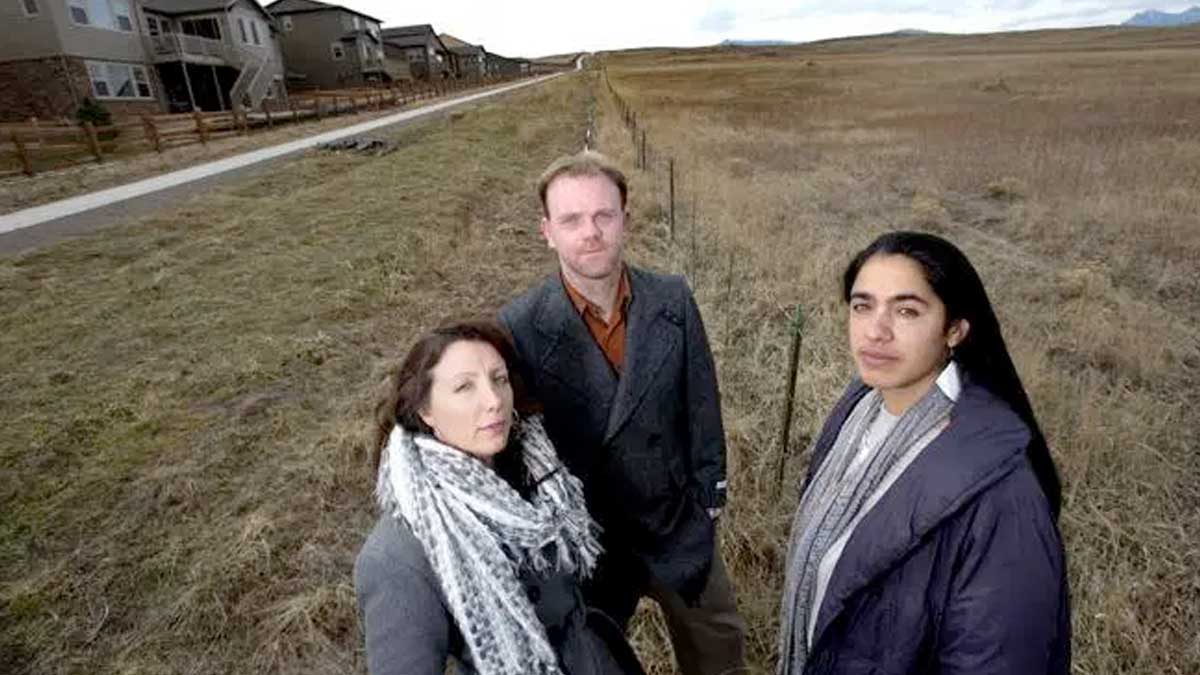
Originally posted Jan 29, 2015 / by Charlie Brennan / Website: https://www.dailycamera.com/2015/01/29/hungry-goats-offered-as-alternative-to-proposed-burn-at-rocky-flats-refuge/
Lani Malmberg is ready, willing and able to bring 1,000 goats to Rocky Flats. Or 2,000, if that’s what it takes.
A self-described “gypsy goat herder” who has worked all over the country and frequently in Colorado and Wyoming, Malmberg said she could eliminate the need for a possible 701-acre controlled burn at the Rocky Flats National Wildlife Refuge by turning her goats loose there.
The U.S. Fish and Wildlife Service is poised to make a decision soon whether to go ahead with the burn this spring, as part of its management plan of the former nuclear weapons plant property, in order reduce its fuel load and to corral invasive species.
Hearing that the agency considers grazing to be currently not feasible, Malmberg used a one-word rejoinder redolent of what is typically managed in a barnyard with a sturdy shovel.
“I am a scientist and my animals are my tools, so I can’t allow them to be hurt and I’m not afraid to work there and I never have been,” Malmberg said Thursday, while driving on Interstate 70 near Grand Junction. “As a scientist and a wise person, it’s insane to burn that.”
The refuge was created in 2006 in the wake of the nuclear weapons site’s closure, and a $7 billion cleanup was finished in 2005. Concerns that a controlled burn there could put plutonium into the air have caused Boulder’s Rocky Mountain Peace and Justice Center and surrounding communities to take a stance against that happening.
Malmberg, who has a master’s in weed sciences from Colorado State University, noted, “I have been called several times over the years about coming to Rocky Flats to work, and I have been called by everybody except those who manage Rocky Flats.”
A spokesman for the Fish and Wildlife Service eight-state Mountain-Prairie regional office in Denver confirmed it’s that agency’s current position that grazing is not an option at the Department of Energy weapons plant-turned-wildlife refuge. The reason cited was a lack of “infrastructure,” such as fencing and staff.
But the spokesman also said the agency’s position could change at an upcoming meeting where a decision to burn or not to burn is expected to be rendered.
‘Why would you have to euthanize them?’
Malmberg, who said her goats already have been deployed on open space in Broomfield and Westminster, said, “I would bring over 1,000, and I could be there all year. The rule of thumb is, one goat, per acre, per season.”
Based on density and variety of vegetation, property owners’ needs and weather, she said 1,000 of her goats could take care of 2 to 50 acres a day; 2,000 would handle 4 to 100 acres per day.
At a presentation Monday at Broomfield’s Rocky Mountain Metropolitan Airport to the Rocky Flats Stewardship Council, refuge manager David Lucas left many of those in attendance with the impression that putting the goats — or any other livestock — to work on the former nuclear weapons production plant property was off the table.
In a slide presentation by Lucas to the group, under “alternatives,” the grazing option carried this notation: “Not feasible (at this time).”
Lucas was not available Thursday for comment. However, in a prepared statement, Fish and Wildlife regional spokesman John Bryan said, “Other management tools are being considered by the service at this time, and no final decision has been made.
“As always, the service is working extensively with state, county and other federal organizations to ensure we have the right information to make the best decision for Rocky Flats NWR, while guaranteeing safety for the public.”
The Colorado Department of Public Health and Environment on Jan. 20 issued a permit allowing for the burn in what is known as the South Woman Creek area at the southwestern edge of the refuge, just north of Arvada’s Candelas development.
David Abelson, executive director of the stewardship council, whose membership includes 10 local governments — Boulder County, the city of Boulder, Broomfield and Superior among them — believes grazing is no longer being considered as an option and said the issue is strongly being driven by perceptions.
“Based on my understanding, the reason that fish and wildlife tabled it wasn’t because of lack of effectiveness of that option, but rather, fish and wildlife’s perception that the concerns that were being raised about the fire would also be raised about the use of grazing animals,” said Abelson, who lives in Boulder.
The stewardship council, whose leaders represent 900,000 area residents, has voted unanimously to oppose the burn, basing that vote, Abelson said, not on known risk but on public perception and concern.
Boulder City Councilwoman Lisa Morzell is Boulder’s representative to the stewardship council, and she was also at Monday’s meeting. She elaborated on what she perceived to be the reason for Fish and Wildlife Service’s disinterest in grazing the refuge back to ecological health.
“He (Lucas) said that grazing was not going to be considered, because he would have to euthanize the animals that were grazed, and then would have to deal with the aftermath of protests from animal rights people, who are upset about the euthanization of the animals,” Morzell said.
That made no sense, she argued.
“Why would you have to euthanize them?” Morzell asked. “They are not used for milk or meat, they are used for grazing. And the individual that owns these goats is able to make a sufficient income, that way. They are not intended for dairy or for meat.”
Goat-herd has no worries over deploying herd at Flats
Michele Gabrieloff-Parish, a Superior mother of three and member of the activist group Candelas Glows — named for the development just south of the refuge and proposed burn area — said, “It sounded like they were worried more about the health of the goats, than the people who are going to inhale the particles or contaminants suspended due to the burn.”
Malmberg, likening 1,000 goats to “110,000 pounds of living energy” whose presence would build the health of the terrain as they worked it, said she would not be concerned about her animals’ health at Rocky Flats.
“I have no worries, because I don’t think those dangerous things are in the plant material right now, and the goats are eating the plant material,” she said.
Malmberg is focused instead on what is in the soil at Rocky Flats. The soil is also among Gabrieloff-Parish’s chief worries.
“I’m concerned about the soil being bare for even any length of time” in the wake of a burn, Gabrieloff-Parish said. “The winds out there are so strong, if you had a week of bare soil, you’d have an inch of soil blow away.
“Even if you are very conservative about the effects of the fire, it’s still very worrying and troublesome. That’s the legacy of the site. It is complicated. I don’t think anybody knows everything about the site.”
Charlie Brennan: 303-473-1327, brennanc@dailycamera.com or twitter.com/chasbrennan
